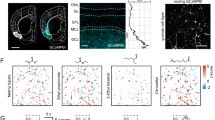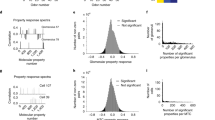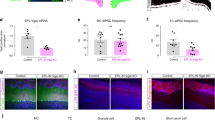Abstract
Glomeruli are functional units in the olfactory system. The mouse olfactory bulb contains roughly 2,000 glomeruli, each receiving inputs from olfactory sensory neurons (OSNs) that express a specific odorant receptor gene. Odors typically activate many glomeruli in complex combinatorial patterns and it is unknown which features of neuronal activity in individual glomeruli contribute to odor perception. To address this, we used optogenetics to selectively activate single, genetically identified glomeruli in behaving mice. We found that mice could perceive the stimulation of a single glomerulus. Single-glomerulus stimulation was also detected on an intense odor background. In addition, different input intensities and the timing of input relative to sniffing were discriminated through one glomerulus. Our data suggest that each glomerulus can transmit odor information using identity, intensity and temporal coding cues. These multiple modes of information transmission may enable the olfactory system to efficiently identify and localize odor sources.
This is a preview of subscription content, access via your institution
Access options
Subscribe to this journal
Receive 12 print issues and online access
$209.00 per year
only $17.42 per issue
Buy this article
- Purchase on Springer Link
- Instant access to full article PDF
Prices may be subject to local taxes which are calculated during checkout



Similar content being viewed by others
Change history
30 September 2013
In the version of this article initially published online, ref. 37 and the sentence "In addition, flies can learn to discriminate odors using only a single class of olfactory sensory neuron37" in the second paragraph of the Discussion were not present, and the following sentence, concerning the mammalian olfactory system, referred to "learned behavior" rather than simply "behavior." The error has been corrected for the print, PDF and HTML versions of this article.
References
Hildebrand, J.G. & Shepherd, G.M. Mechanisms of olfactory discrimination: converging evidence for common principles across phyla. Annu. Rev. Neurosci. 20, 595–631 (1997).
Mori, K. The olfactory bulb: coding and processing of odor molecule information. Science 286, 711–715 (1999).
Wilson, R.I. & Mainen, Z.F. Early events in olfactory processing. Annu. Rev. Neurosci. 29, 163–201 (2006).
Ressler, K.J., Sullivan, S.L. & Buck, L.B. Information coding in the olfactory system: evidence for a stereotyped and highly organized epitope map in the olfactory bulb. Cell 79, 1245–1255 (1994).
Vassar, R. et al. Topographic organization of sensory projections to the olfactory bulb. Cell 79, 981–991 (1994).
Mombaerts, P. et al. Visualizing an olfactory sensory map. Cell 87, 675–686 (1996).
Malnic, B., Hirono, J., Sato, T. & Buck, L.B. Combinatorial receptor codes for odors. Cell 96, 713–723 (1999).
Koulakov, A., Gelperin, A. & Rinberg, D. Olfactory coding with all-or-nothing glomeruli. J. Neurophysiol. 98, 3134–3142 (2007).
Rubin, B.D. & Katz, L.C. Optical imaging of odorant representations in the mammalian olfactory bulb. Neuron 23, 499–511 (1999).
Bozza, T., McGann, J.P., Mombaerts, P. & Wachowiak, M. In vivo imaging of neuronal activity by targeted expression of a genetically encoded probe in the mouse. Neuron 42, 9–21 (2004).
Wachowiak, M. & Cohen, L.B. Representation of odorants by receptor neuron input to the mouse olfactory bulb. Neuron 32, 723–735 (2001).
Macrides, F. & Chorover, S.L. Olfactory bulb units: activity correlated with inhalation cycles and odor quality. Science 175, 84–87 (1972).
Chaput, M. & Holley, A. Single unit responses of olfactory bulb neurones to odor presentation in awake rabbits. J. Physiol. (Paris) 76, 551–558 (1980).
Spors, H., Wachowiak, M., Cohen, L.B. & Friedrich, R.W. Temporal dynamics and latency patterns of receptor neuron input to the olfactory bulb. J. Neurosci. 26, 1247–1259 (2006).
Stewart, W.B., Kauer, J.S. & Shepherd, G.M. Functional organization of rat olfactory bulb analyzed by the 2-deoxyglucose method. J. Comp. Neurol. 185, 715–734 (1979).
Soucy, E.R., Albeanu, D.F., Fantana, A.L., Murthy, V.N. & Meister, M. Precision and diversity in an odor map on the olfactory bulb. Nat. Neurosci. 12, 210–220 (2009).
Potter, S.M. et al. Structure and emergence of specific olfactory glomeruli in the mouse. J. Neurosci. 21, 9713–9723 (2001).
Zhang, J., Huang, G., Dewan, A., Feinstein, P. & Bozza, T. Uncoupling stimulus specificity and glomerular position in the mouse olfactory system. Mol. Cell Neurosci. (2012).
Smear, M., Shusterman, R., O'connor, R., Bozza, T. & Rinberg, D. Perception of sniff phase in mouse olfaction. Nature 479, 397–400 (2011).
Sobel, E.C. & Tank, D.W. Timing of odor stimulation does not alter patterning of olfactory bulb unit activity in freely breathing rats. J. Neurophysiol. 69, 1331–1337 (1993).
Carey, R.M., Verhagen, J.V., Wesson, D.W., Pirez, N. & Wachowiak, M. Temporal structure of receptor neuron input to the olfactory bulb imaged in behaving rats. J. Neurophysiol. 101, 1073–1088 (2008).
Suh, G.S.B. et al. A single population of olfactory sensory neurons mediates an innate avoidance behavior in Drosophila. Nature 431, 854–859 (2004).
Semmelhack, J.L. & Wang, J.W. Select Drosophila glomeruli mediate innate olfactory attraction and aversion. Nature 459, 218–223 (2009).
Stensmyr, M.C. et al. A conserved dedicated olfactory circuit for detecting harmful microbes in Drosophila. Cell 151, 1345–1357 (2012).
Uchida, N. & Mainen, Z.F. Speed and accuracy of olfactory discrimination in the rat. Nat. Neurosci. 6, 1224–1229 (2003).
Abraham, N.M. et al. Maintaining accuracy at the expense of speed: stimulus similarity defines odor discrimination time in mice. Neuron 44, 865–876 (2004).
Rinberg, D., Koulakov, A. & Gelperin, A. Speed-accuracy tradeoff in olfaction. Neuron 51, 351–358 (2006).
Shepherd, G.M. & Greer, C.A. Olfactory bulb. in The Synaptic Organization of the Brain, 4th edn. (ed. Shepherd, G.M.) 159–203 (Oxford University Press, New York, 1998).
Aungst, J.L. et al. Centre-surround inhibition among olfactory bulb glomeruli. Nature 426, 623–629 (2003).
Liu, S., Plachez, C., Shao, Z., Puche, A. & Shipley, M.T. Olfactory bulb short axon cell release of GABA and dopamine produces a temporally biphasic inhibition-excitation response in external tufted cells. J. Neurosci. 33, 2916–2926 (2013).
Apicella, A., Yuan, Q., Scanziani, M. & Isaacson, J.S. Pyramidal cells in piriform cortex receive convergent input from distinct olfactory bulb glomeruli. J. Neurosci. 30, 14255–14260 (2010).
Davison, I.G. & Ehlers, M.D. Neural circuit mechanisms for pattern detection and feature combination in olfactory cortex. Neuron 70, 82–94 (2011).
Mori, K. & Sakano, H. How is the olfactory map formed and interpreted in the mammalian brain? Annu. Rev. Neurosci. 34, 467–499 (2011).
Rinberg, D., Koulakov, A. & Gelperin, A. Sparse odor coding in awake behaving mice. J. Neurosci. 26, 8857–8865 (2006).
Kato, H.K., Chu, M.W., Isaacson, J.S. & Komiyama, T. Dynamic sensory representations in the olfactory bulb: modulation by wakefulness and experience. Neuron 76, 962–975 (2012).
Hopfield, J.J. Odor space and olfactory processing: collective algorithms and neural implementation. Proc. Natl. Acad. Sci. USA 96, 12506–12511 (1999).
DasGupta, S. & Waddell, S. Learned odor discrimination in Drosophila without combinatorial odor maps in the antennal lobe. Curr. Biol. 18, 1668–1674 (2008).
Acknowledgements
We thank C. Guo and the gene targeting facility at Janelia Farm for generation of chimeric mice, B. Weiland for technical help with cloning and gene targeting, M. Karlsson for designing the behavioral controller box, and K. Svoboda, G. Fishell, R. Egnor and Y. Sirotin for comments on the manuscript. This work was supported by the Visiting Scientist Program at the Janelia Farm Research Center. T.B. was supported by funding from the National Institute on Deafness and Other Communication Disorders (R01DC009640 and R21DC010911), the Whitehall Foundation and the Brain Research Foundation.
Author information
Authors and Affiliations
Contributions
M.S., T.B. and D.R. designed the study. M.S. and D.R. built the experimental setup. A.R. developed software for behavioral experiments. M.S. and A.R. performed the experiments. M.S., A.R. and D.R. analyzed the behavioral data. J.Z. and T.B. performed the electrophysiological recordings. J.Z. and T.B. analyzed the electrophysiological data. T.B. initiated the transgenic approach and generated the gene-targeted mice. M.S., T.B. and D.R. wrote the manuscript. D.R. and T.B. supervised the project.
Corresponding authors
Ethics declarations
Competing interests
The authors declare no competing financial interests.
Integrated supplementary information
Supplementary Figure 1 High-power monoglomerular activation can be detected in the presence of M72 ligand.
High-power monoglomerular activation can be detected in the presence of M72 ligand. Detection performance for low (20 mW; data as in Fig. 2C) and high (40 mW) stimulus power in the absence and presence of methyl benzoate (10-3 of saturated vapor pressure), an M72 ligand, is shown. Increasing light stimulus power evokes above-chance detection performance.
Supplementary information
Supplementary Text and Figures
Supplementary Figure 1 and Supplementary Table 1 (PDF 281 kb)
Rights and permissions
About this article
Cite this article
Smear, M., Resulaj, A., Zhang, J. et al. Multiple perceptible signals from a single olfactory glomerulus. Nat Neurosci 16, 1687–1691 (2013). https://doi.org/10.1038/nn.3519
Received:
Accepted:
Published:
Issue Date:
DOI: https://doi.org/10.1038/nn.3519
This article is cited by
-
Long-range GABAergic projections contribute to cortical feedback control of sensory processing
Nature Communications (2022)
-
Spatial information from the odour environment in mammalian olfaction
Cell and Tissue Research (2021)
-
Young adult-born neurons improve odor coding by mitral cells
Nature Communications (2020)
-
Transfer functions linking neural calcium to single voxel functional ultrasound signal
Nature Communications (2020)
-
Mesoscopic and microscopic imaging of sensory responses in the same animal
Nature Communications (2019)



